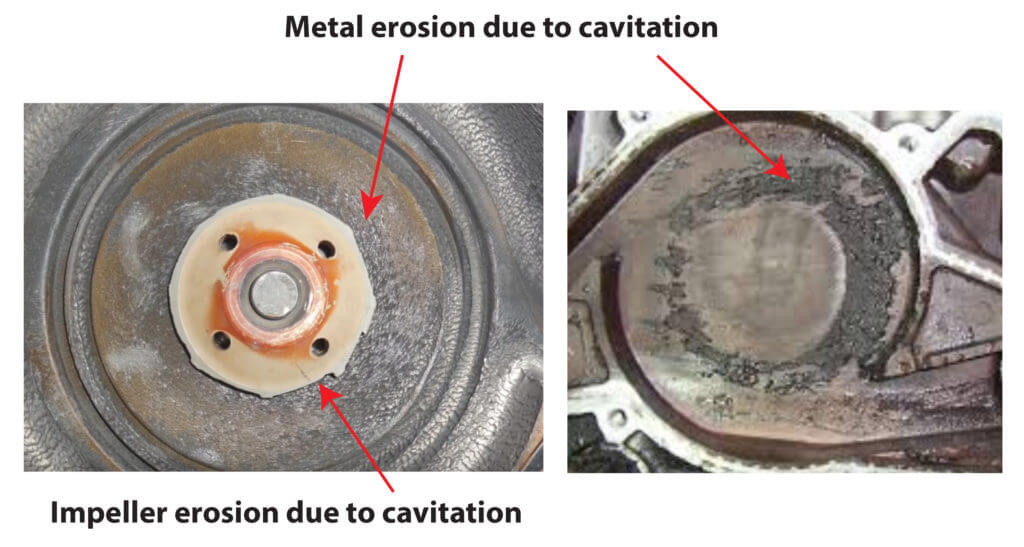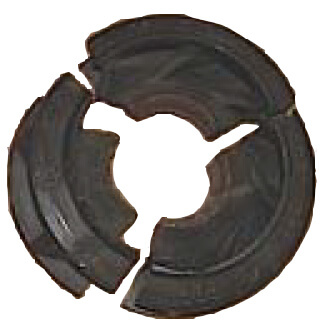Water pump cavitation
What is water pump cavitation?
Water pump cavitation is the erosion of plastic and metal components due to the formation of tiny bubbles of super heated vapor. The bubbles are formed due to a difference between vapor pressure and cooling system pressure or the pressure and suction created by the pump. The super heated vapor eats away at the water pump housing and the impeller, causing premature water pump failure and engine overheating. The bubbles of superheated steam attack metal and plastic almost as if they were being shot at the housing from a sand blasting gun.

Water pump cavitation
Cavitation can be caused by a difference between vapor pressure and cooling system pressure
Here’s an example. You know that the radiator cap helps an engine cooling system build pressure, usually 9-15-psi. A cooling system needs pressure to increase the boiling point of the coolant. Let’s say you remove the radiator cap on a hot engine while it’s running, which is something you should never do. Once you remove the cap, you release the pressure in the system, which lowers the coolant’s boiling point. The hot coolant turns to steam. So any loss of cooling system pressure can lead to steam formation and cavitation. This is a VAPOR pressure loss. Again, it’s the difference between normal cooling system pressure and something less than cooling system pressure that lowers the boiling point of the coolant and creates steam.
Cavitation caused by normal operation of the pump
Now let’s talk about the pressure and suction created by the pump. As the water pump impeller spins, it creates a negative pressure on the inlet side of the pump as it sucks in coolant. The negative pressure scenario is just like the example above, where it lowers the boiling point of the coolant. Only this time the lower pressure it’s created by the action of the pump rather than the removal of the radiator cap. The more negative pressure a water pump creates, the more it tends to create void in the coolant, which is actually superheated steam.
Cavitation is also caused by low coolant level
This one is pretty easy to understand. The system is low on coolant, which means there’s air in the system. The water pump doesn’t have to create the air bubbles; the low coolant level created the air bubbles by itself.
How to avoid water pump cavitation?
Pay attention to the water/coolant ratio
Coolant condition plays a direct role in whether your water pump will create cavitation. In fact, improperly mixed coolant (water versus concentrated coolant) changes its specific gravity and that changes how the water pump operates.
Water cools an engine better than coolant, but it should never be used in your engine because it doesn’t contain any anti-corrosive additives. Coolant manufacturers usually recommend a 50/50 water/coolant mix, but may suggest a 30/70% mix in very cold climates to prevent freezing. If the water/coolant ratio if off spec, it will effect engine cooling efficiency AND promote cavitation.
If coolant concentration is higher than 50%, you’ll lose cooling efficiency and that extra heat can promote cavitation.
Worn coolant causes water pump cavitation
Engine coolant contains an additive package with wetting agents or

Plastic impeller damaged by high acidity and cavitation
surfactants to reduce surface tension, allowing the coolant to transfer heat more efficiently. The additive package also includes buffers to control pH and anti-corrosion additives to prevent Galvanic action (electrolysis).
As the additive package wears or depletes, the coolant tends to run hotter and become more acidic. That damages all plastic components in the cooling system, especially plastic water pump impellers.
Corrosion in the radiator causes water pump cavitation
Again, if the coolant can’t transfer heat, it runs hotter and that causes steam bubbles that result in cavitation.
Corrosion also causes leaks and leaks reduce cooling system pressure, which lowers boiling point, which causes steam.
Signs of cavitation
Engine overheating due to higher steam content and impeller degradation
Water pump leaks through the weep hole.
©, 2018 Rick Muscoplat
Posted on by Rick Muscoplat
